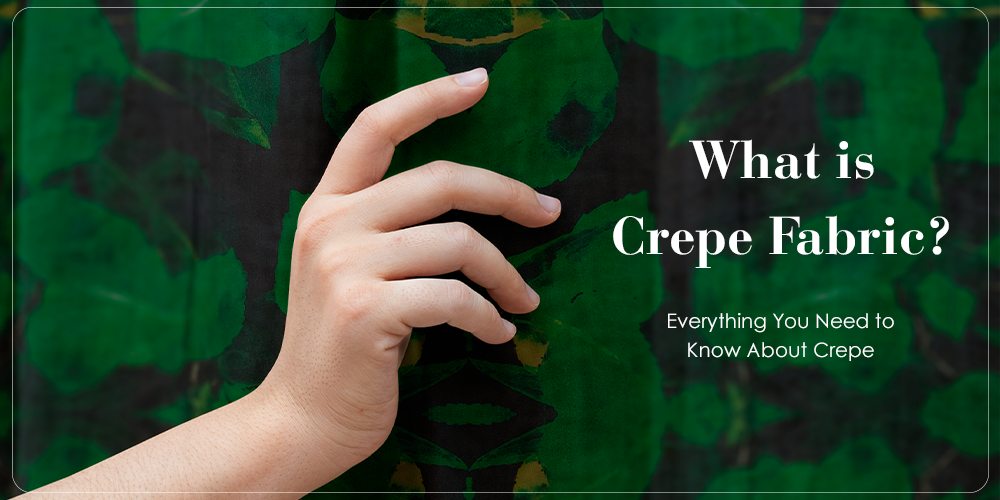Crepe is a thin, crinkled cloth with a wrinkled look.
Crepe fabric was formerly solely created from silk, but currently it may be made from a variety of textiles such as cotton, chiffon, and rayon. Furthermore, because it can be made in a variety of ways, it is appropriate for a variety of events and seasons. In fact, you've probably worn crepe-based clothing or worked with it previously.
Crepe is now mostly utilized in high fashion and other sorts of artistic clothing design. All of these distinct varieties of crepe fabrics have one thing in common: they are all created through an intricate process of weaving and knitting to achieve the crinkled but light look.
How is crepe fabric made?
The basic fabrics used in crepe fabric can be made using a variety of different procedures. The main distinguishing element of this type of cloth is its weave. Nowadays, even a fabric that is made unconventionally and carries the ‘look’ of crepe is also considered ‘crepe’ fabric.
Complex twisting is the first step in the process of creating crepe fabric. Crepe yarn is made by tightly twisting textile strands in this technique. After the yarn is made, the next step is to make it into clothes, which includes dyeing, sewing, and other processes.
Characteristics of Crepe Fabric
Crepe fabric can have a unique combination of properties depending on the fibre makeup. To further grasp what crepe fabric is, let's go over some of its characteristics:
- Highly breathable - Fortunately, crepe does not disappoint when it comes to breathability. The fabric is exceedingly light and transparent in appearance, allowing air to flow easily through it.
- Versatility - The features of a crepe product can vary dramatically depending on the content and characteristics of the fibres used to make the crepe fabric.
- Appearance - Crepes are suitable for people of all shapes and sizes. Crepe's ability to add a lovely fall or drape to a dress, gown, skirt, or pair of pants makes it a popular choice for formal wear.
- Sustainability - Organic crepe textiles developed using environmentally friendly ingredients and techniques are more sustainable than synthetically produced crepe fabrics. Sustainable crepe textiles help to improve the environment by decreasing waste, conserving water, and having a lower environmental effect overall.
Types of Crepe Fabrics
As previously stated, crepe fabrics exist in a variety of styles. Here are a few that are most popularly used in various applications around the world.
- Crepe de Chine - Crepe de Chine is a light-weight fabric composed mostly of silk. The silk crepe de Chine fabric does not have the puckered surface of other crêpes; rather, it has a smooth, matte finish with minor pebbling.
- Wool Crepe - Wool crepe, often known as crepon, is a wiry crepe fabric made from a blend of cotton and silk fibres. When the yarn is treated during weaving, the cloth takes on a distinct appearance. Dresses and lingerie are frequently made with it.
- Polyester Crepe - Polyester crepe, one of the most often used crepe fabrics, is used for blouses, dresses, and any other piece of apparel that requires a lovely drape and fall.
- Crepe Charmeuse - Crepe charmeuse is a silk fabric made using crepe twist yarns using the satin weave method. Silk charmeuse has a dull back and is smooth and reflective like satin. The crepe yarns provide the cloth its distinctive crepe definition.
- Crepe-Back Satin - Crepe-back satin is a satin crepe fabric with one side having a smooth and velvety satin feel and the other having a crinkled crepe appearance and feel.
Is Crepe Fabric Good for Summer?
Because crepe fabric comes in a variety of colours and patterns, certain crepes are appropriate for summer while others are not. In general, cotton crepe fabric and stretch crepe fabric are the best types of crepe to use in the summer. They're made of light, breathable fabrics that don't cling to the skin and don't chafe it.
Conclusion
Crepe and its numerous varieties provide a great deal of elegance and adaptability for clothing and home design. You may appreciate its airy drape and crisp, textured feel by sewing something lovely with crepe today with a little preliminary work utilising the advice and information provided above.
If you are looking to buy Crepe Fabric and make it a part of your everyday wardrobe, order crepe fabric from fabricbysinghanias today.



